By Lee Freeman, Florence-Lauderdale Public Library, Local History-Genealogy Dept.
One of the factories which put Florence on the map in the late 19th-early 20th centuries was the Florence Wagon Works, founded by native New Yorker and retired physician (due to a hearing impairment) Dr. Alfred David Bellamy (1847-1913), its first president and a businessman from Atlanta (Bellamy’s first cousin was noted author Edward Bellamy) as the Atlanta Wagon Works in 1882. Anecdote has it that the Florence Wagon Factory soon became the second largest wagon manufacturing company in North America, second only to Studebaker.


Left, founder and first president of the Florence Wagon Co., Dr. Alfred David Bellamy. Right, the factory as it looked in 1890.
The Atlanta Wagon Factory came to East Florence in February of 1889, from Atlanta, at the height of Florence’s industrial boom–one of about 60 manufacturing plants and businesses then located in the booming city. Bellamy relocated the factory to Florence due to the nearby forests of timber and the Tennessee River, stating that it was cheaper to ship wagons from Florence than Atlanta.
On May 15, 1889, the “Florence Wave” reported that the company’s capital stock was $200,000 and the paint shop dimensions were 64 by 120 feet, the warehouse 56 by 122 feet (“both two stories”) and the machine shop 100 by 200 feet (“two stories high, with corrugated iron sheeting”).
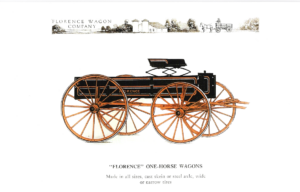

Left, the Wagon Factory in 1903. Right, a “One Horse Wagon” from the company’s 1938 catalogue.
The company built and sold both one-horse and two-horse wagons, cotton frame and seed box thimble skein wagons, caissons, drays, log trucks, its famous Farmer’s Handy Wagon (patented by CW Robinson in 1894), etc. The Wagon Factory also manufactured and sold buggies through its subsidiary the Florence Vehicle Company, founded in 1905 and located in the old Florence Hotel Building (now 111 S. Court St.). The company’s machine shop also did job machine work, as well as planing, matching and dressing lumber.
Florence Wagons were so smooth-running that the factory adopted the logo “The Light-Running Florence.” In fact, so smooth-running were Florence Wagons that, when in October of 1905 the Murfreesboro, Tennessee, Business League held a contest to see who could haul the largest number of people into Murfreesboro using only two horses, local resident GW Thompson won the contest using a 3½ Florence Log Wagon and “two ordinary farm mules” to carry 86 men at an estimated combined weight of 13,000 lbs. two miles into town. Thompson later said he “took my wagon home uninjured. I did not get the weight of my load.” The firm subsequently used Thompson’s letter to the company and the photo of the 86 men on his wagon in a factory advertisement.

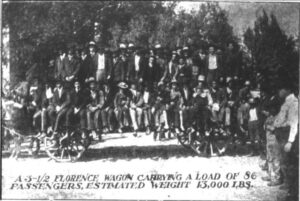
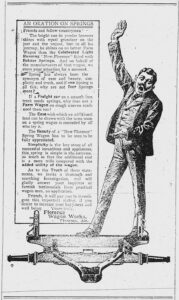
Above, left, company poster of ca. 1903 featuring the phrase “The Light Running Florence.” Center, photo of Murfreesboro, TN resident GW Thompson’s 3½ wagon loaded with 86 men with an estimated combined weight of 13,000 lbs. From a company advertisement from the “Florence Times” of February, 1905. Right, “An Oration of Springs,” a company newspaper ad from March, 1901, highlighting the “bolster springs” used on Florence wagons.
By June of 1889, the company was working 200 white and black hands. By 1900, that number dropped to 100 and by 1892 to 75 but by 1907 had increased to 250. However, by 1933, the number of employees was only 33. My great-great grandfather Wiley Francis Freeman (1847-1913) and his two sons, Miles and Dan, worked at the factory in the late 1890s and early 1900s.

 Left, employees of the Florence Wagon Works, ca. 1915. Right, former African-American employee Louis Taylor in 1974 at the remnants of the old Wagon Works railroad trestle. Ironically, Taylor drove a truck in the 1920s or ’30s for a company which still manufactured horse-drawn wagons.
Left, employees of the Florence Wagon Works, ca. 1915. Right, former African-American employee Louis Taylor in 1974 at the remnants of the old Wagon Works railroad trestle. Ironically, Taylor drove a truck in the 1920s or ’30s for a company which still manufactured horse-drawn wagons.
In September of 1894 the factory shipped 528 wagons. By 1897, its annual capacity was 6,000 wagons—this would later increase to 15,000. Situated on the river, the plant was more like a self-contained village than a factory. The factory complex boasted segregated housing (a few of these old two-story frame houses are still standing), its own fire brigade and water tower (moved from Handy’s Hill in West Florence in 1897), commissary, brass band, newsletter (“The Wagging Tongue”) and YMCA, as well as a library and a Sunday school founded by Bellamy, a devout Baptist. The factory also had its own steamboat landing and railroad spur and contained state-of-the-art equipment and machinery, including a machine shop by 1889; “an electric clock with seven stations throughout the works” by 1893; electric lights by 1894; five telephones, one in each department by 1895; a 50-horsepower boiler in 1899; an “addressograph and “rapid roller copying” machine in 1900; and a $7,000 indoor sprinkler system by 1901. In addition, by 1901 the company had switched to the “Boston or continuous” system of dry-houses.

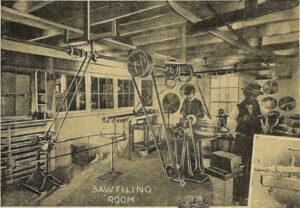
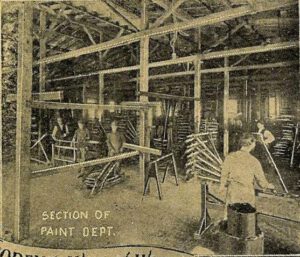
Above, from left, at the Wagon Factory, 1903, the wood department, saw filing room and the paint department.
Between 1896 and 1900, Bellamy and the company officers investigated relocating the plant to Birmingham, Memphis or Nashville but opted to remain in Florence. During WWI, the company built wagons for the US Army’s Expeditionary Force in France. Prior to this, it shipped orders of wagons to several oversees locations and foreign countries, including Hawaii, Puerto Rico, India, South Africa, Russia and Mexico.
As demand for wagons decreased in the 1920s and 30s, the factory was not able to diversify despite briefly manufacturing a line of lawn or porch furniture and kitchen tables. Finally in April of 1941, the Wagon Factory buildings were sold to Trenholm & Starr of Chattanooga. The new owners planned to use the buildings for some sort of defense work in WWII but they never did. By June of 1943, the “Florence Herald” reported that the building material of the “wrecked old Wagon Works,” including all sizes of lumber, metal roofing and windows–free of nails–was for sale. In 1941 the last remnants of the company were bought and relocated to Hickory, North Carolina. Some employees, made the move, too.
In its 52 years of service, the Florence Wagon Company made the phrase “Light Running Florence” a household word.
Florence native Lee Freeman has been the local historian-genealogist at the Florence-Lauderdale Public Library since 1997. The author of one book & several articles, he serves on local historical & historical preservation boards & is a sometime consultant for the MSNHA.
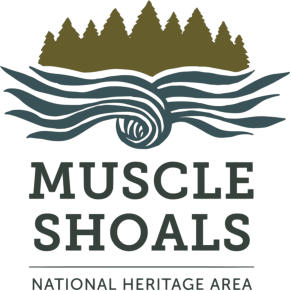



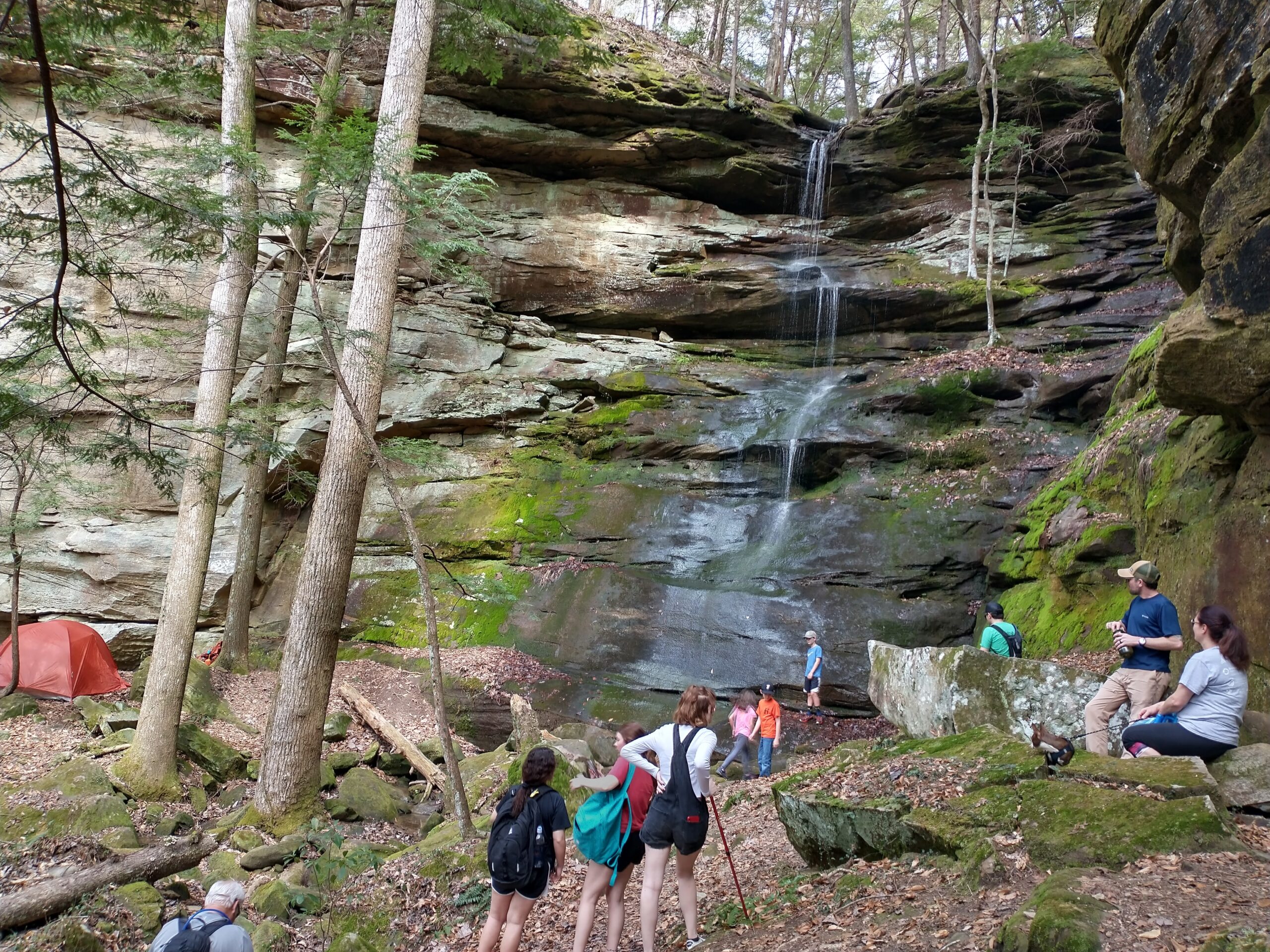

2 Responses
I have been told my grandfather Andrew Hamilton Hefner drove a team of miles for Florence Wagon Works. Don’t have anyway to verify this. Do you know of any records or available literature?
Fred — What a great family memory! We always recommend starting with the Florence-Lauderdale Public Library’s Local History Department. It has an amazing archived database of Florence history, and the folks working there are always willing to help. Find more info at https://www.flpl.org/local-history/